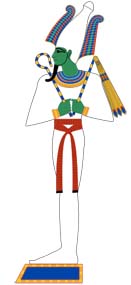Osiris - Egyptian God of the Underworld
Osiris, the Egyptian god of the underworld, appears to have been a strong element in Egyptian mythology from the beginning. Before he became the Egyptian god of the underworld, Osiris had quite a history.
Who Was Osiris?
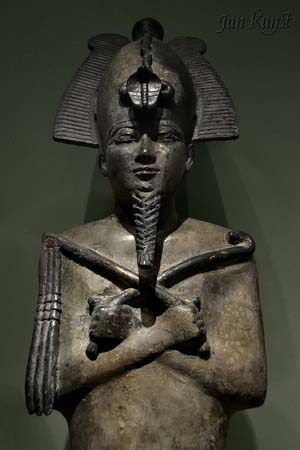
© Jan - Statue of Osiris
Osiris was the ancient Egyptian god of the dead, the underworld, and the afterlife. He is usually depicted as a man with green skin and a beard associated with the pharaoh, wearing a crown with two large ostrich feathers, and legs partially wrapped like a mummy. In his hands he holds a flail and a symbolic crook.
His Names
Osiris is a Latin word. In Egyptian hieroglyphs the traditional rendering of the name is Wsjr. Some Egyptologists refer to the deity as Aser, Ausar, Asar, Asari, Ausir, Ausare, Usire, Usir, Wser, or Wesir. The English translation of the name is Almighty or The Powerful.
This is how he was perceived among the ancient Egyptians and his name was celebrated with much prayer and ritual activity for thousands of years. He was also worshiped as the shepherd god. Archaeologists point to him being pictured with the shepherd's crook as evidence of this designation.
Titles of Osiris
His name appears during Egypt's Fifth Dynasty, although he is said to have been worshiped since the First Dynasty. He is also mentioned in later Egyptian documents, including the Contending of Horus and Seth, the Shabaka Stone and the writings of ancient Greek authors.
Osiris was given many titles. He is sometimes referred to as "King of the Living" and "Foremost of the Westerners". Both of those titles were given to him because of his being the ruler of the dead, whom the ancient Egyptians called Westerners or The Living Ones.
Considered to be a merciful judge of people in the afterlife, Osiris is also credited with the fertile flooding of the Nile, the sprouting of vegetation, and the granting of all life. Some of his other titles and attributes include the Lord of Silence, the Lord of Love and He Who is Permanently Benign and Youthful.
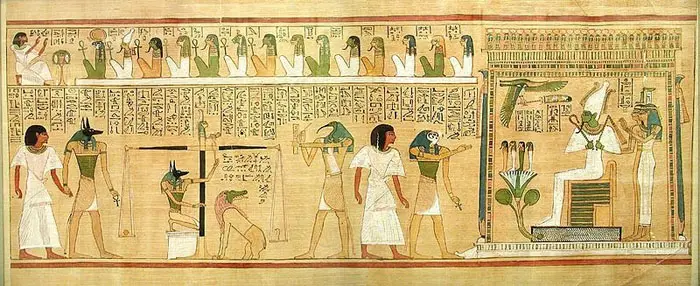
©GoShows - Osiris (right, seated) at the Weighing of the Heart Ceremony
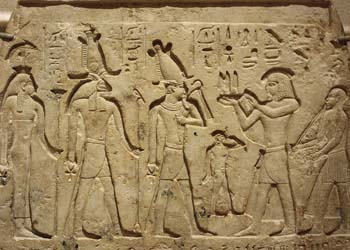
© Peter Roan - Osiris (Centre), Reliefs
His Appearance
Ancient paintings of Osiris often have him colored green or black. Green is said to be the color ancient Egyptians associated with rebirth. Black was the color associated with fertility: it was the color of the rich, fertile soil which stretched over the plains each year, when the River Nile overflowed, and played a huge role in Egypt's prosperity.
In some rare instances, Osiris was depicted wearing a crown that included a rendering of the moon. This has led some researchers to surmise he was associated with the moon or the night.
History of Osiris
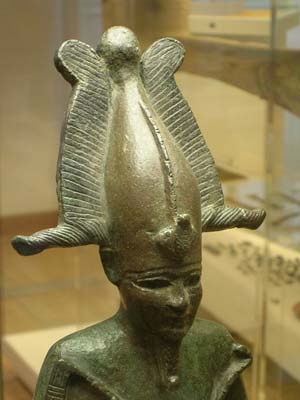
© Xenocryst - Osiris Statuette
Osiris is told to have been one of five children born to the god of the earth and the goddess of the skies, Geb and Nut respectively. Through this family tree he was also a great-grandson of one of the most popular Egyptian gods, Ra. Osiris had four younger siblings who would also play critical roles in his story: his brother Seth and two sisters known as Isis and Nephthys.
As the firstborn child and son of Geb and Nut, it fell to Osiris to inherit the throne of Egypt. Seth married Nephthys and Osiris married Isis. Together, Isis and Osiris seemed to have possession of numerous powers. Their marriage was not destined to be happy, however.
At one point, Nephthys appears to have magically taken on the appearance of Isis and presented herself to Osiris as his wife. Not knowing the difference, Osiris was seduced by Nephthys and she became pregnant and gave birth to Anubis.
Later, Seth developed a vendetta against his extremely popular sibling, possibly either because Osiris had inherited the throne or because he had gotten Seth's wife pregnant. At any rate, Seth sought to kill him by luring him into a coffin and drowning him in the Nile. The annual flooding of the Nile River is still thought to be representative of this event.
Isis managed to recover her husband's body; however Seth was very stealthy and stole away with it. After cutting up the body of the Egyptian god of the underworld, Seth hid the pieces throughout the Egyptian desert.
The connection between Isis and Osiris was so strong that the Egyptian goddess proceeded to spend a number of years searching for the mutilated body parts of her husband. She finally managed to find all of the pieces save one, and is believed to have used her magical powers to restore her husband's body.
Although there are different versions to this part of the story, it seems Isis became pregnant, presumably by Osiris and gave birth to a son, Horus. Osiris died once again and descended to fully assume his duties as Egyptian god of the underworld.
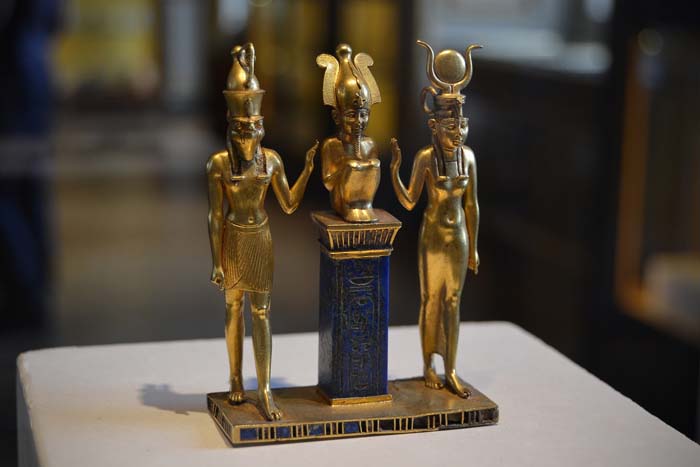
© Jan - Osiris (center) with Isis and Horus
Some versions of the history of Osiris state that when he descended into the underworld he took over several important roles and duties as Egyptian god of the underworld from Anubis, who was believed to have been his son. Other tales contend that he rightfully obtained the important role as Egyptian god of the underworld because he was the first god to have died. However he obtained the role, it became Osiris' responsibility to judge the souls of the dead.
Fertility, Resurrection, and Everlasting Life
It is said the dead kings of Egypt would rise with Osiris and inherit eternal life. By Egypt's New Kingdom it was said not only would the dead kings rise from the dead with him, but any Egyptian that performed the appropriate rituals would also. This belief that Osiris is responsible for new life after death caused him to be associated with the New Year and the cycles of nature.
His worship continued to be popular until the rise of Christianity. At that time the Romans began to suppress the Egyptian religion and actively promote Christianity. Even in the face of active Roman suppression of the Egyptian religion, many people, Egyptians and others, continued to revere, sacrifice to, and worship him secretly for hundreds of years.
The Significance of the Resurrection
To the ancient Egyptians, Osiris' resurrection after being slain by his evil brother Set represents the new beginning for good after it has defeated evil. To them, the tale was symbolized by the sun going into the world of the dead each night and being reborn with each new day.
As such, he came to be identified as the Creator god who is king of the underworld and the afterlife and who controls life, death, rebirth, and resurrection. A pillar of continuity, representing the phallus created by Isis, became a symbol of the Ba or power of Osiris and was used in his worship.
A Familiar Story
It's not surprising if the story of Osiris sounds familiar. Many of the elements of his story are similar to the death and resurrection of Jesus. Where their stories are very different is what is said to happen to people after they die.
Ancient Egyptians believed the deities Anubis, Ammut, Henefer, Ma'at, Osiris and Thoth would greet the person in the afterlife and perform the weighing of the heart ceremony. The person's heart was weighed against the feather of Ma'at. If it was lighter than the feather they had lived a good, truthful life and would spend eternity in the kingdom of Osiris.

©GoShows - Osiris (right, seated) at the Weighing of the Heart Ceremony
Worship
In ancient Egypt, worship of Osiris was an important part of their everyday life. The story of his death at the hands of Seth and his 72 accomplices was retold each year as part of their worship. It was a story of regeneration and rebirth they saw play out each year with the cycle of the flooding of the Nile.
Egypt was a very fertile place, one of the breadbaskets of the Old World. The ancient Egyptians attributed much of this to Osiris and they held many ceremonies to give praise to his name, actions, and attributes.
Seen as the first king of Egypt, his symbols, the flail and the shepherd's staff, became important symbols of the pharaohs that came after him. His reign was viewed as the ideal which succeeding Egyptian rulers attempted to emulate. To his followers, he represented a time of peace, unity, and fertility.
Osiris was the good shepherd who was loved by his people and it was felt that paying homage and venerating him would help Egypt and Egyptians to be successful. It was believed worshiping him would forever ensure fertility, prosperity and plentiful crops on the banks of the Nile.
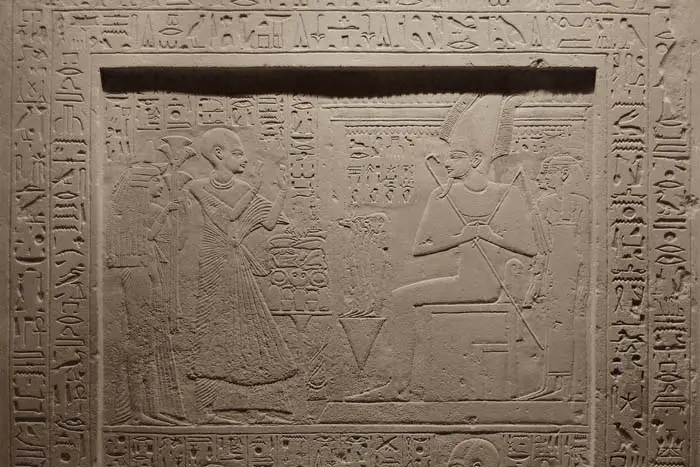
© Jan - Royal butler Paatenemheb and his wife Tipuy worshiping Osiris
Celebrations
The celebrations dedicated to Osiris, including the Great Mystery Festival and a 5 day religious ritual, were held each spring. They included plays, story telling, religious services, feasting, and fun. Some of the celebrations commemorated his life by planting grain moistened with water from the Nile in gardens in the shape of Osiris. The grain's subsequent germination and growth symbolized his death and resurrection.
Egyptians believed the sprouting grain symbolized his unwavering vitality and strength. The people praised Osiris as 'The one who came from heaven and was the bread which sustained the lives of mankind'. He was called 'The one who continues to be perfect'. These celebrations were held in the last month of the inundation of the Nile.
Osiris Facts
- Osiris was one of Egypt's most important deities.
- His exact origin is obscure, but he was known to have been a local god in Busiris, a city in Lower Egypt.
- He was worshiped in the temple at Abydos.
- He was later worshiped as the Hellenistic god Serapis.
- Greco-Roman writers associated him with Dionysus.
- Many modern people mistakenly refer to the Eye of Horus as the Eye of Osiris.
- Recently a 3,200 year old replica of the tomb of Osiris was discovered in in Sheikh Abd el-Qurna on Thebes' West bank.

